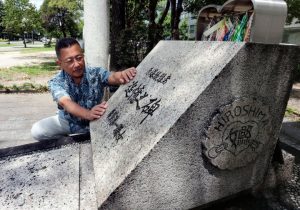Summer following conclusion of Hiroshima summit—Did G7 leaders truly see Hiroshima? Part 4: Roadside memorial cenotaphs
Jul. 24, 2023
Monuments show regrets surrounding mobilized students killed in atomic bombing
by Yu Kawakami, Staff Writer
“If only she hadn’t worked that day…”
Peace Boulevard runs east and west through downtown Hiroshima. Shaded by trees planted on the boulevard’s greenbelt, a memorial monument for A-bombed students and staff from Hiroshima Prefectural First Girls’ High School (Prefectural Girl’s School; present-day Minami High School) stands quietly in the Komachi area of the city’s Naka Ward at the site of the school’s front gate. Yo Hosokawa, 64, a resident of Naka Ward, peered at his aunt’s name inscribed on the monument’s nameplate and said quietly, “If only she hadn’t worked that day on building demolition, she would have survived.”
“6,000 students died”
During the Pacific theater of World War II, the mobilization of boys and girls for work was promoted as a national government policy to compensate for labor shortages. According to the Hiroshima Peace Memorial Museum, located in the city’s Naka Ward, about 8,000 students at former junior high schools and girls’ high schools were mobilized on August 6, 1945, to participate in the demolition of buildings in Hiroshima’s central area to prevent the spread of potential fires caused by air raids. About 6,000 of those students are thought to have died in the atomic bombing.
Mr. Hosokawa’s aunt, Yoko Moriwaki, 13 at the time, described her joy at becoming a student at the Hiroshima Prefectural Girls’ School, which she had long admired, in a journal entry dated April 6, the day of her school’s entrance ceremony. Later, she continued to write about how she was enjoying school life with friends even as air raid alarms sounded. Her diary ended with an entry dated August 5, in which she wrote, “Starting tomorrow, I’ll organize the work of dismantling buildings. I’ll give it my all.”
The following day, Ms. Moriwaki “left her home on Miyajima Island early in the morning to handle her work as class president,” as described by Mr. Hosokawa. She and her classmates gathered at the area of Dobashi-cho (now part of Naka Ward). She was exposed to the bombing’s thermal rays at a location about 800 meters from the hypocenter, suffering burns over her entire body and dying at a relief station on the outskirts of the city that night. All 223 first-year students at her school who had been mobilized at the time died in the bombing. Inscribed on the monument are the names of 301 victims, including students in other grades, teachers, and staff.
No chance for monuments to draw attention during summit
On May 19, the initial day of the summit meeting of the G7 (Group of Seven industrialized nations) held in Hiroshima, Mr. Hosokawa visited the monument, at its location along Peace Boulevard, a road established on the remains of a former wartime fire lane. With traffic halted under the tight security in place during the summit, the boulevard had been lined with crowds of people trying to get a glimpse of the convoy of vehicles carrying world leaders to Peace Memorial Park in the city’s centrally located Naka Ward. “The G7 summit was significant in that the gathered global leaders passed by on the road developed by children during wartime. I want the hope for peace to remain long, like burning embers, in the hearts of the leaders.”
Nevertheless, more than 80 monuments for A-bomb victims erected along the boulevard received little attention. In front of the museum is located the A-bomb Monument for the Hiroshima First Municipal Girls’ School (present-day Funairi High School), which lost 514 first- and second-year students that had been mobilized to the same area. “Hiroshima was just exploited by the summit for political purposes,” snorted Miyako Yano, 92, an A-bomb survivor living in the city’s Nishi Ward. Ms. Yano, then a second-year student at the municipal girls’ school, did not participate in the work that day because she felt unwell.
Students were not the only ones to be mobilized for the work of dismantling buildings for firebreaks in the downtown area. A total of 180 people from the Kawauchi Village (now part of Asaminami Ward), located about 10 kilometers north of the hypocenter, also died while they were mobilized as members of the village’s Volunteer Fighting Corps. The Monument for the Volunteer Army Corps stands on the east bank of Honkawa River near Peace Memorial Park. Convoys of G7 leaders’ vehicles repeatedly passed in front of the monument.
Toshiki Kamimura, 69, grandson of Shigeru Kamimura, who died at in 1981 at the age of 85, continues his work as a farmer in Kawauchi Village. Shigeru contributed to establishment of the monument for victims from his community as chair of the area’s bereaved family association. In Toshiki’s words, “My grandfather lost many friends and acquaintances. He must have been saddened by that loss. Some of the G7 leaders probably caught sight of the monument, which is reflective of local sentiment.”
(Originally published on July 24, 2023)







